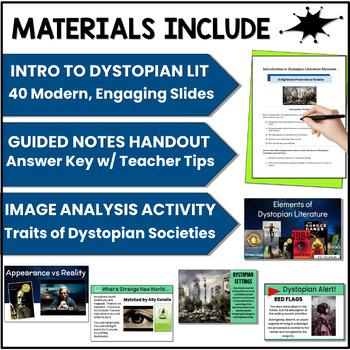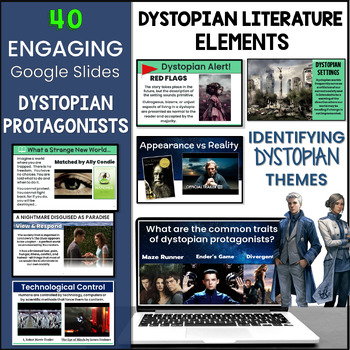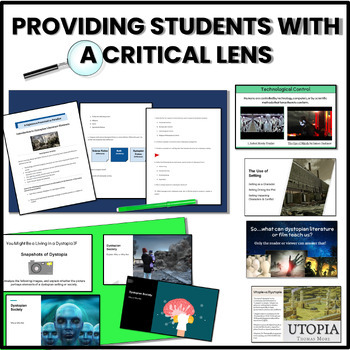Dystopian Literature Introduction Short Story Unit Activity - Dystopia Theme
- PDF
- Google Apps™

What educators are saying
Description
The Introduction to Dystopian Literature provides the critical lens students need to analyze elements of dystopia! The riveting materials and thought-provoking activities support the analysis of any dystopian short story or novel. The 40 engaging and informative slides, along with application activities, will prepare your students to confidently analyze dystopian settings and motifs.
This resource benefits students by facilitating higher levels of learning beyond a basic introduction to the dystopian literature genre! They'll examine the author's purpose for writing this type of story and gain awareness of the common literary techniques that dystopian writers use.
This Introduction to Dystopian Literature resource includes the following activities and materials:
- Table of Contents with resource links, teacher's notes, pacing guide, and a list of applicable Academic Anchor Standards for Reading
- 40 Elements of Dystopian Lit Google Slides providing a modern and engaging introduction to this exciting genre
- Convenient links to engaging and relevant movie and book trailers
- Questions and a note-taking student handout with an answer key for accountability to reinforce learning
- A high-interest Dystopian Settings Image Analysis Activity with 17 images for analysis and application
- Answer keys for all activities
- Bonus Resource - Dystopian Society Graphic Organizer for students to identify dystopian elements in any novel or short story
- PDF Teacher's Guide with Google Drive Resource Links
- Directions for Microsoft Office users and instructions on how to optionally print handouts
This resource was recently enhanced and updated with additional materials! Students love viewing the popular young adult film and book trailer clips that are easily accessible from the Introduction slides presentation! Video clips include relevant film excerpts from Matched by Ally Condie, The Giver by Lois Lowry, The Eye of Minds by James Dashner, the iRobot movie trailer, and Unwind by Neal Shusterman!
Your students will be provided with background knowledge of the following dystopian literature elements:
- Origins of Dystopia
- Dystopia vs. Utopia
- Dystopian Literature, Science Fiction, and Speculative Fiction
- Allegory and Satire
- Author's purpose for writing
- Common dystopia motifs and themes
- Means used to oppress and dehumanize society
- Elements of a dystopian setting
- Characteristics of a dystopian protagonist
- Common literary devices and figurative language used within this genre
The final activity will hook your students as they analyze 17 images and defend whether the visual portrays the traits of a dystopian society!
This resource also includes a bonus graphic organizer designed specifically for this genre. The Dystopian Society Graphic Organizer with guiding prompts will facilitate your students' literary analysis of any applicable work!
This purchase includes a pdf file with Google share links to all materials.
Set your students up for success before reading dystopian literature with this engaging resource pack!
This resource supports the following Common Core Academic Anchor Standards for Reading:
Range and Level of Text Complexity
CCRA.R.10: Read and comprehend complex literary and informational texts independently and proficiently.
Key Ideas and Details
CCRA.R.1: Read closely to determine what the text says explicitly and to make logical inferences from it; cite specific textual evidence when writing or speaking to support conclusions drawn from the text.
Craft and Structure
CCRA.R.4: Interpret words and phrases as they are used in a text, including determining technical, connotative, and figurative meanings, and analyze how specific word choices shape meaning or tone.
Integration of Knowledge and Ideas
CCRA.R.7: Integrate and evaluate content presented in diverse media and formats, including visually and quantitatively, as well as in words.
*************************************************************************************
Interested in extending your study of Dystopian literature? Check out the Welcome to Dystopia teaching resource bundle! The bundle includes this resource, a Dytopian literature analysis activity, and a Dystopian Images Analysis Slides Presentation and Student Response Sheet!
Welcome to Dystopia - A Nightmare Disguised as Paradise ( A Dystopian Lit Unit)
*************************************************************************************
You can find all my resources for Google Drive and Google Classroom HERE.
*************************************************************************************
.





